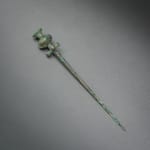Group of Bronze Pins with Globular Finial, 900 BCE - 700 BCE
Bronze
height 23.5 cm
height 9 1/4 in
height 9 1/4 in
LO.702
Further images
Numerous are the pins in the Luristan cultural sphere, the most important site where they have been gathered being the Surkh Dum shrine. In its religious compounds pins were apparently...
Numerous are the pins in the Luristan cultural sphere, the most important site where they have been gathered being the Surkh Dum shrine. In its religious compounds pins were apparently deposited in large numbers. They also appear regularly in burial contexts, but occasionally in settlements, suggesting a predominant ceremonial connotation. Yet simple straight garment pins with plan upper shanks were also commonly used in the area from the 3rd millennium BC onwards until they were superseded in the 8th century BC, when the fibula, or safety pin, replaced them.
In the late Bronze Age and early Iron age period they became much more ornate and increasingly decorated with animal- or floral- shaped heads. Although some of these pins could be light enough to be worn as dress pins, many are much too large and heavy for a mundane function and possibly had a ritual connotation, such as those found in the already cited Surkh Dum shrine, which were found built into the stone walls and served as religious symbols or icons.
In the case of the pins here illustrated, the shape of the shank, resembling a pomegranate with four cylindrical projecting appendages below it, is consistent with the production of the early 1st millennium BC in Luristan.
A similar group has been published by Houshang Mahboubian, The Art of Ancient Iran, 1998.
In the late Bronze Age and early Iron age period they became much more ornate and increasingly decorated with animal- or floral- shaped heads. Although some of these pins could be light enough to be worn as dress pins, many are much too large and heavy for a mundane function and possibly had a ritual connotation, such as those found in the already cited Surkh Dum shrine, which were found built into the stone walls and served as religious symbols or icons.
In the case of the pins here illustrated, the shape of the shank, resembling a pomegranate with four cylindrical projecting appendages below it, is consistent with the production of the early 1st millennium BC in Luristan.
A similar group has been published by Houshang Mahboubian, The Art of Ancient Iran, 1998.





